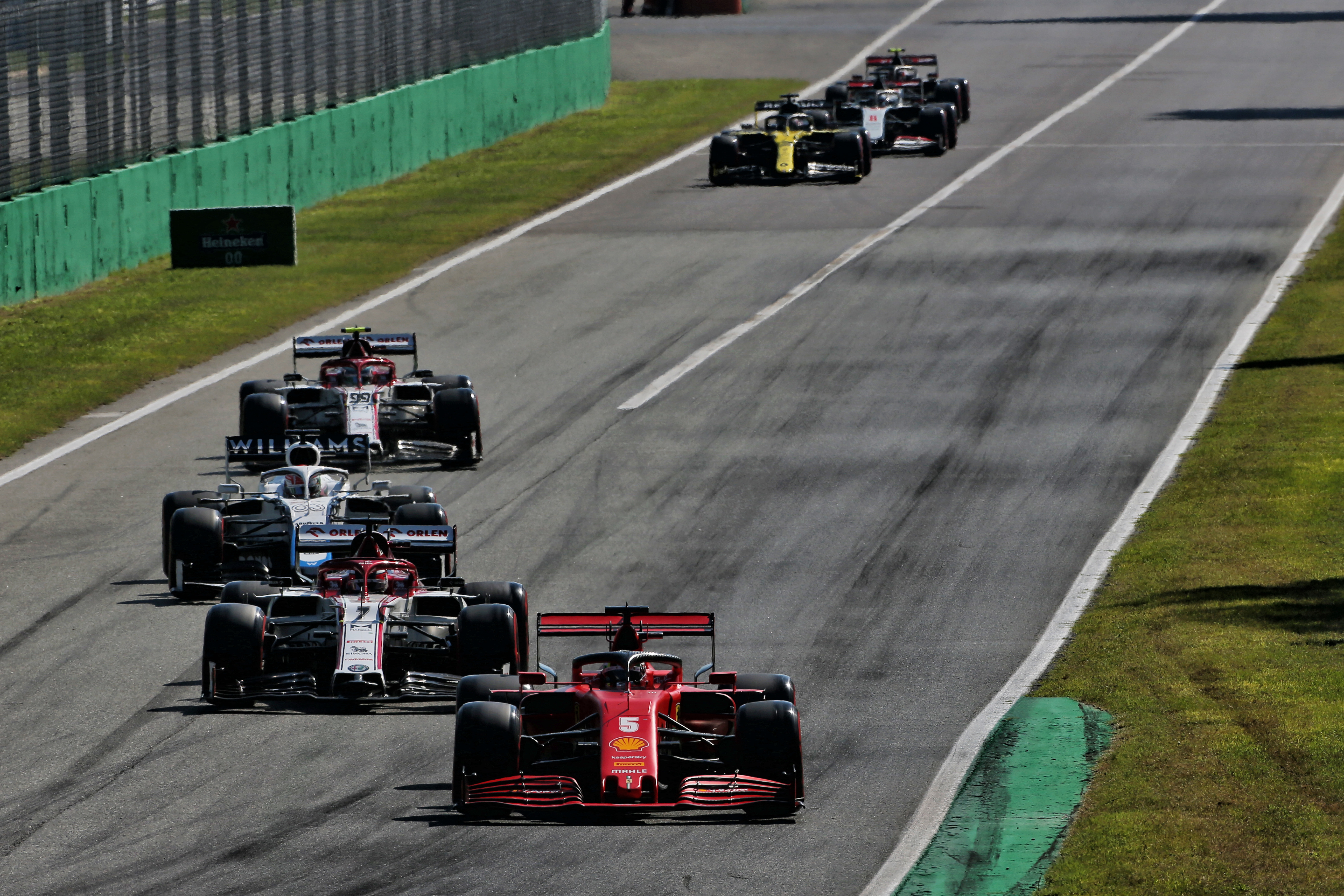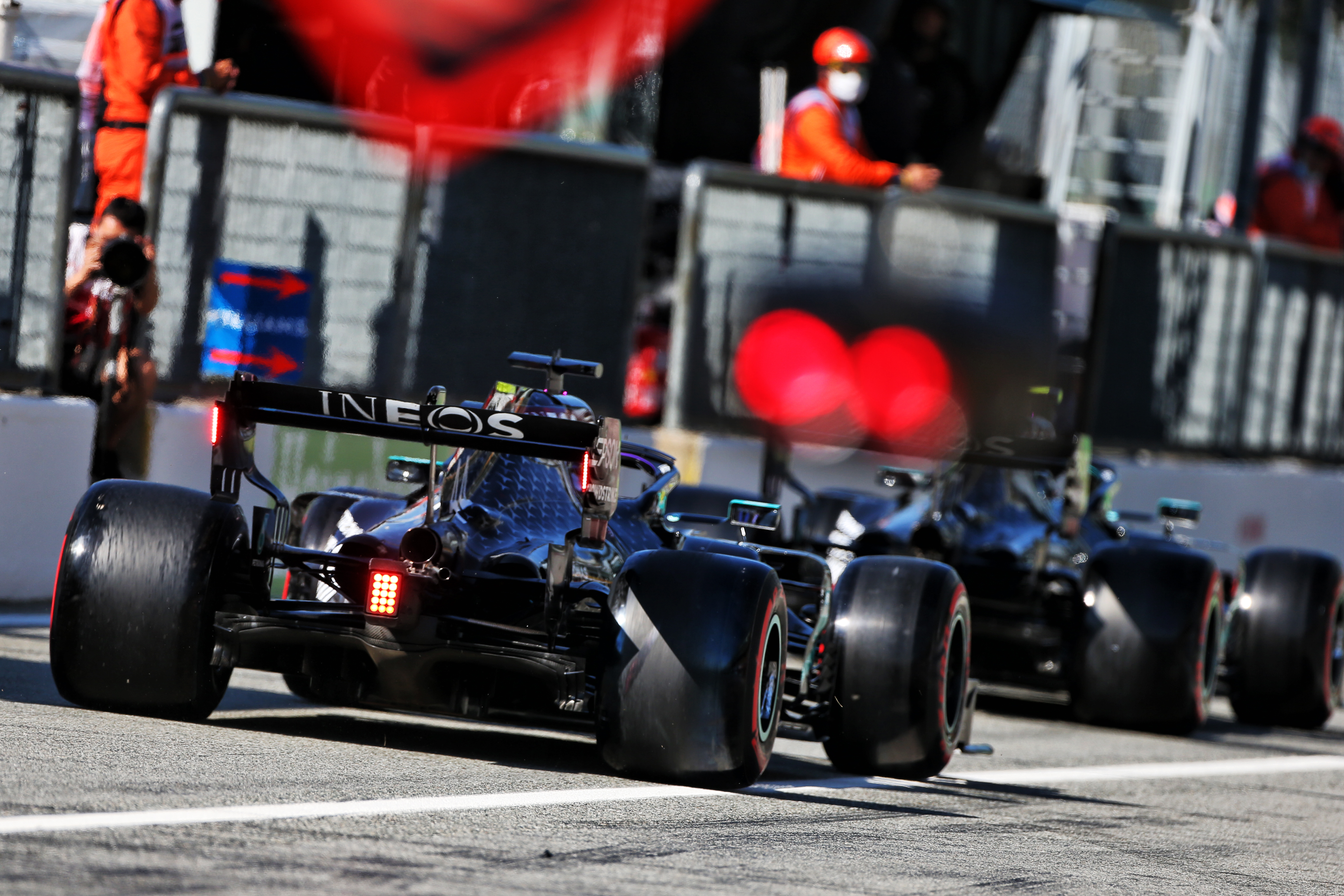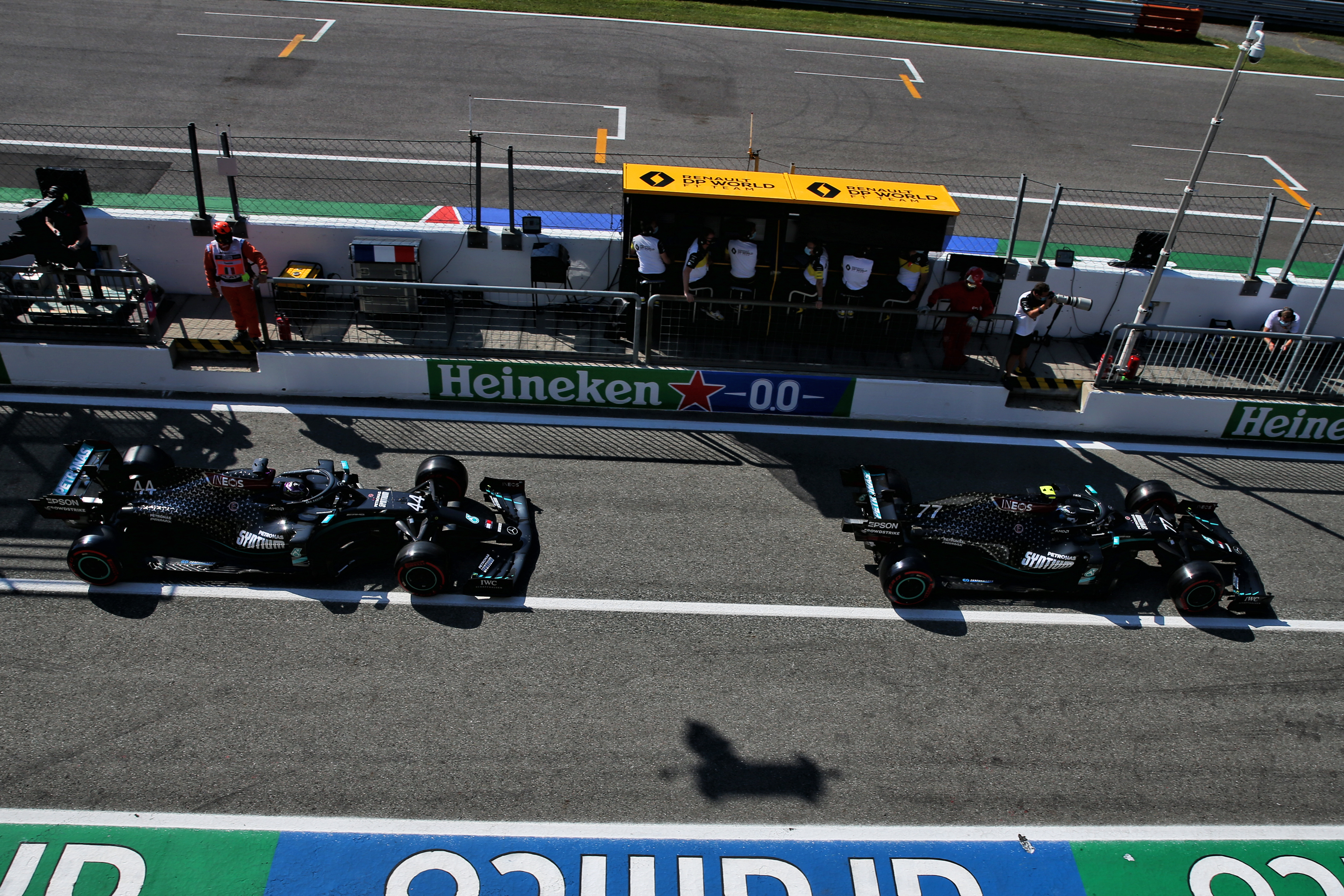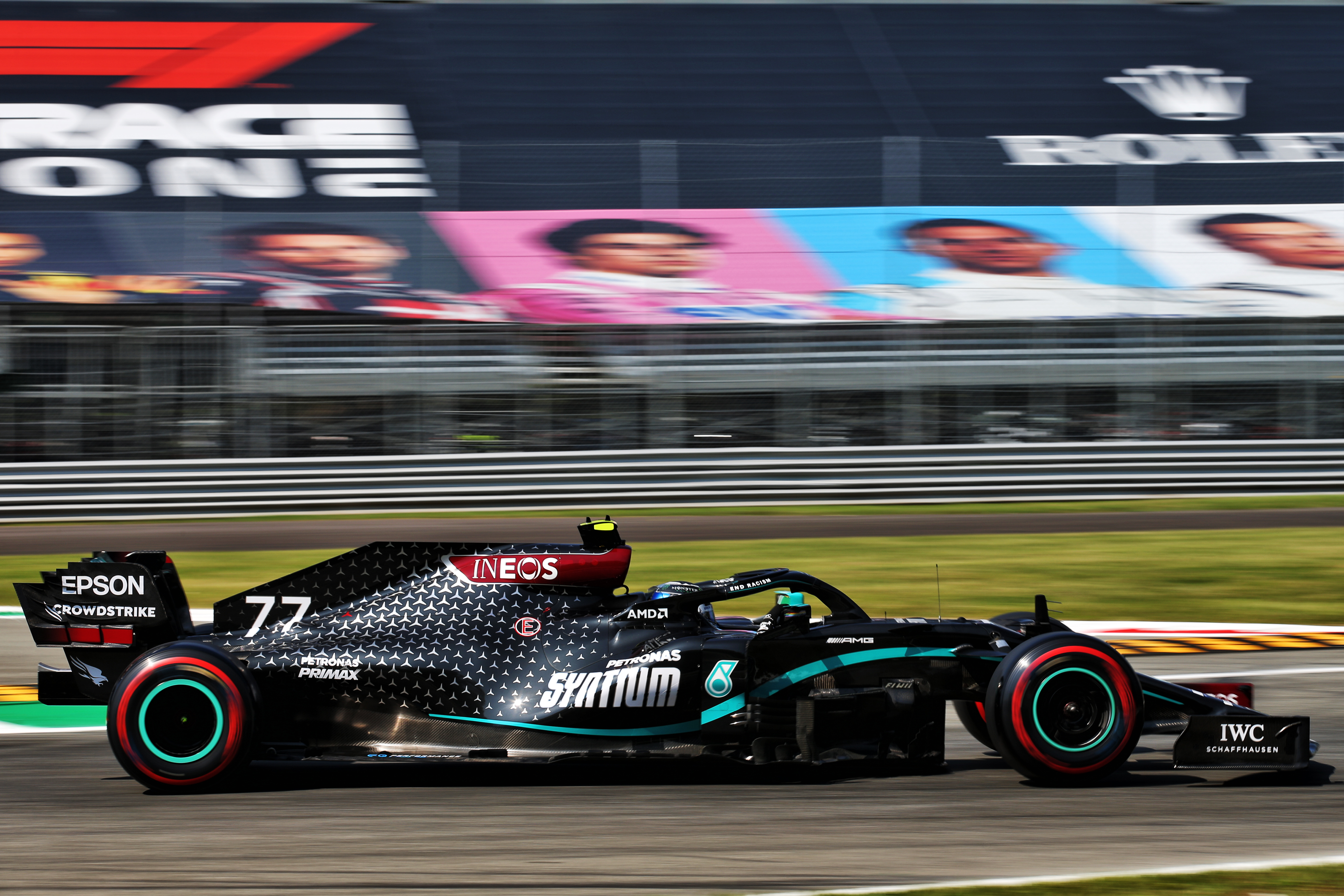Up Next

Mercedes insisted for weeks it feared no serious threat from Formula 1’s ‘party mode’ ban. But actions speak louder than words, and there was no greater act of confidence than Mercedes attacking qualifying at Monza without even worrying about getting a tow.
While others squabbled over track position and sought to ensure they didn’t miss out on vital tenths, Lewis Hamilton and Valtteri Bottas traded the slipstream for clear air. The result was a Mercedes front row 0.8s clear of the opposition.
“Not sure how happy Red Bull is now with this engine change,” Bottas smiled after qualifying.
The joke was merited. F1’s governing body has insisted this in-season rule change was about improving the manner in which it may police the complex energy recovery systems, but Mercedes’ rivals have been hinting, if not outright pushing, for some qualifying mode clampdowns for a while.
Red Bull team boss Christian Horner had said it would be “healthy” for the championship. Senior Red Bull figure Helmut Marko told Auto Motor und Sport after the Belgian Grand Prix that Mercedes’ “extreme” qualifying mode was “distorting” the competition.
On the face of Monza qualifying, the first test of the new directive, not so much. Now teams need to run one mode through qualifying and the race. So, if this is Mercedes without an extreme engine mode for qualifying, how much was it holding back before?

That, for the avoidance of doubt, is not a serious question. Mercedes boss Toto Wolff revealed after qualifying that pressure from rivals before the FIA even discussed a technical directive meant it was wary of qualifying modes being banned, and had already begun work on creating the strongest possible compromise that worked across the whole weekend.
“It is the mindset of this team that things change,” he said when asked by The Race about how Mercedes handled the engine mode directive.
“The way we operate is about extracting performance and being as adaptable as an organisation [as possible]. Almost the Darwinist principle to confront every possible situation that comes up.
“Once it was clear that the lobby against our quali mode had grown – much before the TD came out – we shifted our development work towards that situation.”
It’s not that there has been no effect in qualifying. The Race understands that Mercedes has lost two tenths in peak performance by having to switch to a different engine mode for the weekend.
But that is nowhere near enough to blunt the all-round package, and it’s likely that a small drop in performance has also been suffered by Honda and Renault.
Ferrari has apparently registered zero difference because its underpowered 2020 engine didn’t have a party mode to begin with. It remains the engine most affected by technical directives, just not this one – like at Spa one week ago, albeit with wing levels making a direct comparison difficult, Ferrari is 1.5s slower on the straights at Monza than in 2019.

Since the party mode ban was first public knowledge, Mercedes has expressed its belief that it could redistribute performance so that engine power on Sundays was increased.
This is where any lobbying to rein Mercedes in during qualifying may backfire most, because Mercedes was already dominating grands prix. And while Wolff isn’t going to “praise the day before the evening”, there is a confidence coursing through Mercedes and its customer teams that the objective of having even more race-day performance has been achieved.
Unless Mercedes has got its calculations badly wrong and the engine cannot cope in the grand prix, it seems the only thing that is extreme about its engine advantage is that it exists totally – across qualifying and race rather than a special party trick developed for a few precious moments – and that the engine mode directive has actually reinforced this rather than cut into it.
“The biggest advantage we have focused on is to gain race time,” Wolff reminded us on Saturday evening.
“We are pushing the boundaries and therefore we’ve had a really good Saturday and I’m very pleased for the team. Now we need to do well on Sunday.”

Such an emphatic defeat when some had retained genuine hope, or misguided optimism, that Mercedes would slip back (rather than be totally overhauled) has underlined the extent of the engine advantage it has in 2020. But it’s also important to note the role the car plays as well.
Qualifying comparison: 2019 vs 2020
| Team | 2019 | 2020 | Gain |
| Racing Point | 1m20.498s | 1m19.718s | -0.780s |
| AlphaTauri | 1m20.630s | 1m19.909s | -0.721s |
| McLaren | 1m20.202s | 1m19.695s | -0.507s |
| Mercedes | 1m19.346s | 1m18.887s | -0.459s |
| Red Bull | 1m20.021s | 1m19.780s | -0.241s |
| Williams | 1m21.800s | 1m21.587s | -0.213s |
| Renault | 1m19.833s | 1m19.864s | 0.031s |
| Haas | 1m20.615s | 1m20.869s | 0.254s |
| Alfa Romeo | 1m20.515s | 1m20.926s | 0.411s |
| Ferrari | 1m19.307s | 1m20.273s | 0.966s |
The 2020 Ferrari is slower on the straights vs 2019 than it is quicker through the corners. The other two Ferrari-engined teams were also slower than last year, but by a much smaller amount. Renault was also fractionally worse than a year ago.
Of the Honda-powered cars, AlphaTauri has made a huge jump while Red Bull’s progress is minimal, despite Verstappen not taking part in qualifying in 2019.
This is a reflection of car performance and the balance struck for this particular circuit, not just engine power/development year-on-year. As a result, McLaren emerged as the closest competitor to Mercedes as Red Bull slipped from second to fourth, behind Racing Point as well.
Verstappen has been the Mercedes drivers’ biggest annoyance in 2020 but here his time loss to pole is understood to have been all in the corners, with smaller wings and a tow matching the Mercedes in a straight line. The RB16’s inherent lack of performance, or at least the weakness Verstappen described at low-downforce, meant it was losing too much elsewhere.
For Mercedes to still find a healthy gain of almost half a second shows the performance of its all-round package, especially as it is able to eschew a tow and be fractionally fastest in sectors one and three, then have the downforce to establish a mighty advantage in sector two.
One could argue Mercedes’ is a chicken-and-egg scenario: are the engine and car equally good, or is the car so good because the engine’s powerful enough to let it carry more downforce? But it’s largely irrelevant. The best engine is married to the car with the most downforce. The result is it’s pummelling the opposition, with or without a party mode.

Monza will not act as the definitive snapshot for the impact (or lack of impact) caused by the FIA’s engine mode technical directive. In addition to one data set not being sufficient for any wider analysis, Monza is an extreme outlier because of the sensitive relationship between laptime and getting a tow, and the scope for set-up compromise being so different.
One methodology that underlines that is a supertime comparison, where laptimes are expressed as a percentage of the outright fastest. If we take each team’s Monza supertime vs their pre-Monza average for the season, we can see just how much of a shift there is.
Italian GP supertime vs 2020 average pre-Monza
| Team | Gain/Loss (%) |
| AlphaTauri | -0.716 |
| Renault | -0.601 |
| McLaren | -0.593 |
| Alfa Romeo | -0.540 |
| Haas | -0.479 |
| Racing Point | -0.289 |
| Mercedes | 0.000 |
| Red Bull | 0.027 |
| Ferrari | 0.098 |
| Williams | 0.524 |
Low-downforce specialists AlphaTauri, Renault and McLaren shoot to the top in terms of gains, while Alfa Romeo and Haas also compare favourably. Red Bull, Ferrari and Williams (with a draggy car and a messy qualifying) are the losers.
It shows that performance in Monza qualifying, in direct comparison to each team’s performance so far this season, cannot act as a barometer for how much an engine manufacturer was or was not hit by a technical directive.
AlphaTauri’s massive gain can’t be because Honda’s a huge winner from the engine mode change, otherwise Red Bull wouldn’t be worse off. The two Renault teams performing so well in this comparison hints at an easy conclusion for the French manufacturer, but the works team’s laptime is almost identical to a year ago whereas McLaren’s made a big step – so there are clearly other variables at play here.
Basic statistical comparisons need to be viewed as such, and these do reflect one simple fact: Mercedes is still the quickest team. The other known factors – the relatively modest loss of overall performance of two tenths, the competitive straightline speed despite foregoing a tow, and the retention of more downforce for the corners – prop up the argument that the engine mode change has done little to rein it in.

“For us it was important to face this new situation in the most professional way,” said Wolff.
“We knew that this was coming. Once we knew that this is coming, we said OK let’s use it as an opportunity. I think we have a great organisation and the mentality in Brixworth was great.
“They said: ‘Bring it on. Let’s come up with a strong mode for qualifying that we can run all race’.
“Overall we have lost very little qualifying performance. But gained a lot of performance in the race. We can run the engine much harder in the race.
“We were only able to achieve that with a lot of research and a lot of bench running. So far, so good. Let’s see how it pans out with the next sessions.”
To draw many concrete conclusions from one qualifying session would be premature. Sunday’s race will be the first indicator of whether this rule change has, much like the Ferrari gains last year that took Mercedes to breaking point, made the team raise the bar higher.
But there is one clear answer: Mercedes has not lost anything like those lobbying for this rule change would have hoped for, if not expected.




